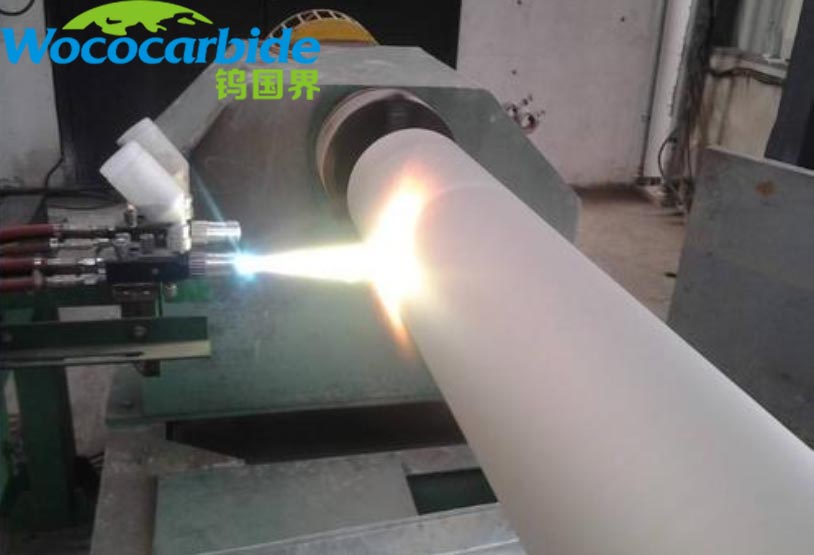

Plasma spray technology has been widely used in traditional fields such as wear-resistant coatings and corrosion-resistant coatings. Since the 1950s, its application fields have expanded from aviation and aerospace to the steel industry, automobile manufacturing, petrochemicals, textile machinery, ships and other fields. In recent years, the application of plasma spray technology in high-tech fields such as nano-coatings, functionally graded materials, superconducting coatings, and biological functional coatings has gradually attracted people's attention.
1 Nano Coating
Plasma spraying found that the hardness, toughness and wear resistance of the coatings were greatly improved compared to conventional coatings. Under the load of 40-60 N, the wear rate of the nano-WC/Co coating is only 1/6 of that of the conventional coating. The University of Connecticut et al. carried out a systematic study of plasma sprayed nanostructured Al2O3-TiO2 coatings, including nano-powder spraying drying agglomeration reconstruction, plasma spraying process parameter optimization, process diagnosis, simulation and coating structure and performance analysis, showing that the coating The layers have a two-state microstructure and exhibit unique and excellent properties. Compared with the corresponding conventional coatings, its bond strength is increased by 100%, the wear resistance is increased by 300%, and the resistance to indentation cracking, bending and cupping tests is higher. The structural changes and particle implantation properties of nano-TiO2 during plasma spraying were investigated by Zhu Yingchun et al. from the Shanghai Institute of Ceramics, China. It was found that the TiO2 nanoparticles changed from amorphous to anatase and rutile structures. The coating exhibits good Li+ injection current and electrochemical stability. Chen Huang et al. prepared zirconia nanocoatings on stainless steel substrates using atmospheric plasma spraying technology. The obtained coating has a dense structure, its porosity is about 7%, and the bonding strength between the coating and the substrate is 45 MPa, which is significantly better than that of the traditional zirconia coating and the substrate.
2 Functional gradient materials (FGMs)

The preparation of gradient functional materials by plasma spraying is one of the research fields that have received much attention in materials science. Due to the high temperature of the plasma flame, it is especially suitable for spraying refractory metal, ceramic and composite material coatings, which provides a wider space for the development of functionally graded materials. At present, the application of ZrO2 coating on metal with NiCrAlY as the intermediate layer has become the focus of most plasma sprayed FGMs structure research, and a good preparation process has been established. In addition, other systems that have been studied include: Cu/W and Cu/B4C, Ni-based alloys combined with Al2O3-Cr2O3, ZrO2 with CoCrAlY or NiCoCrAlY, TiC with Mo, Ni-20 with YSZ coating %Cr, Ni/Al2O3, WC/Co, etc. The study of the YSZ/NiCoCrAlY system by K. A. Khor et al. showed that the functionally graded coating has superior performance compared with the conventional bilayer material. The bond strength of the resulting FGM coating is 18 MPa, and the double-layer coating is only 9 MPa, and the thermal cycle life of the coating is 6 times that of the FGM coating. Sudarshan Rangaraj et al. designed YSZ gradient coatings with five different compositions and studied the effect of coating design on the properties of YSZ coatings. The results showed that the addition of mullite would reduce the driving force of crack growth on the coating surface.
3 Superconducting coating
The arc temperature of plasma spraying is very high, which is especially suitable for spraying composite oxide ceramics. It does not need a protective atmosphere, can spray superconducting parts with complex shapes, has high deposition efficiency, and is easy to prepare thick-film coatings and large-area coatings. The superconducting ceramic coating materials suitable for plasma spraying are mainly YBa2Cu3O7- x (YBCO) and Bi2Sr2Cu2CaO. YBCO is a typical superconducting material with a critical temperature of 94 K. The plasma-sprayed YBCO coating does not have superconducting properties due to inhomogeneities such as oxygen loss of the material during the spraying process, pores, cracks in the coating structure, and uneven contact between particles. Superconductivity can only be obtained by proper heat treatment of the coating in an oxygen or air atmosphere so that the coating forms a dense, uniform and relatively stable crystal structure. The heat treatment conditions of the YBCO coating were 920 °C × 1 h, then decreased to 400 °C for 1 h. When the Bi2Sr2Cu2CaOy ceramic is quenched or quenched from a high temperature, it develops a superconducting state. This feature is of special significance for plasma spraying, because plasma spraying can enable the coating material to obtain a rapid cooling rate of up to 106 °C/s. As long as the plasma spraying conditions and process parameters are adjusted, it is easy to make the as-sprayed coating of Bi2Sr2Cu2CaOy. superconducting properties.
4 Biofunctional coating
Plasma spraying technology is an effective method to prepare medical biocoating materials. The powder materials of specific components are melted at high temperature and deposited on the surface of metal artificial bone implants to form artificial bones and artificial joints with ductile metal as skeleton and ceramic coating on the surface. This method gives full play to the two types of metal and ceramics. The advantages of the material. There are many research reports on plasma sprayed hydroxyapatite (HA) coatings and titanium coatings at home and abroad, and they have been successfully used in clinical trials. The hydroxyapatite coating is non-toxic to organisms, resistant to body fluid corrosion, and has good adaptability and affinity to organisms, is resistant to wear during long-term exercise, and has sufficient mechanical properties. Titanium implants have good chemical stability, are well combined with tissues, and are compatible with body fluids. The use of vacuum plasma spraying to spray titanium coatings on stainless steel roots and bone plates has been successfully used in clinical practice. These coatings take advantage of both the strength of stainless steel and the biocompatibility of titanium coatings to prevent poisoning in stainless steel. release of elements. my country's Shanghai Institute of Silicate Research has also made good progress in the research of biological coating materials.
Hot information

